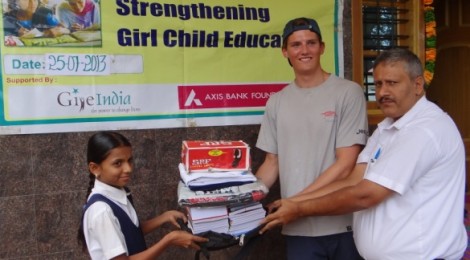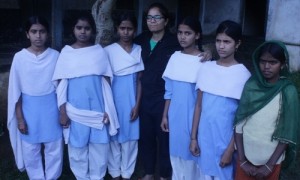
Of all the NGO visits I have done till date, my visit to TRDC has by far been the most unique. A good five-hour drive from Bangalore, TRDC works in 61 villages in the district of Haveri. Wikipedia will tell you that by road, Haveri is about 340 km from Bangalore on the NH-4 towards Mumbai. It also reveals that the name Haveri is derived from the Kannada words havu and keri, which means place of snakes. So if you’re the adventurous kind like me, you can image how excited I was for the trip down.
But what a Google/Wikipedia-search won’t tell you is that a large percentage (60% according to TRDC) of farmers in Haveri are landless labourers. Infact, the term “Haveri landless labourers” is almost a Googlewhack – it throws up just three results! That too totally unrelated to what the situation on the ground is. But spend a day (or three as I did) with Mr. Anil Abbi from TRDC and you’ll learn all about their situation. You’ll also learn that the incidences of child labour in the district are also very high. Child labourers are primarily used here for “cross pollination,” a process which only the delicate touch and hands of children can do successfully. So, this is what prompted him to start working for farmers and their children in the district – which he does through TRDC.
And incase you’re wondering (as I was before I met him) what his affiliation with the area was – he was born and brought up (till class 10) in Haveri himself. We also happened to drive past his parents house while moving from site to site, during our three days here. So the desire to give back is truly to his roots
Given this background, it should come as no surprise then that TRDC does a whole bunch of activities to help in the improvement of the area, as a whole. So from education to employment to climate change to child labour and vocational training, activities are conducted that will help improve the lot of the people in any way possible. Says Dr. Anil Abbi, “We need to prevent migration. Migration happens when the conditions in the village are difficult. And it’s just as difficult, if not more, for these people, when they get to the city. So, by improving the village conditions, we can give them a decent standard of life here itself.” TRDC’s uniqueness is the integrated approach they take to community development. No matter what the activity, they encourage all sections of community to participate in development programmes; and put in extra efforts to include women.
Our first stop (not counting our stop at Kamath’s on the highway for a piping hot breakfast of Uttampams and Dosas) was at their remedial education center at Ranibennur. As the school year was soon to start, girls had been called in (along with a parent/guardian) to collect their school supplies for the year. This included textbooks, notebooks, stationary and a windcheater. On the face of it, this seems like a rather trivial gesture – but the implications are massive. These girls hail from families that live under/close to the poverty line. Education is not a priority for them. Their parents are also unable to comprehend the benefits of the same. So, their families could very easily pull them out of school for any petty reason. These supplies thus act as a great motivator for families to continue sending their girls to school. Infact, that’s the same reason TRDC runs remedial education centers – and not schools themselves. Remedial Education centers work specifically with children who have been identified as academically weak by their teachers. They come to the center every evening after school (4pm-7pm) and get extra help to improve upon their language and Math skills. This effort not only helps reduce school dropout rates but also fortifies the current government school setup in the villages and sends across the message to villagers’ that education is a good and achievable thing to do. It drastically cuts down costs too (for TRDC)!
We also learnt that the structure of remedial education had become very structured, over the years. There’s weekly lesson plans drawn out for the students, tests given at regular intervals to see how the children are improving and a novel “minimum learning level” set that adjudges if students are meeting this minimum learning standard. These processes are adhered to religiously with regular reports being sent to Mr. Anil Abbi himself.
After a busy morning of distributing school supplies, interactions with parents, and understanding the processes of the remedial educational center, we enjoyed a very delicious lunch (which included raw and surprisingly non-bitter Methi (Fenugreek) leaves for salad). Our next stop was to the highschool at Hosahulihalli. Our troupe also included Axel, a youth from Sweden, who is interning with TRDC for six-weeks through the AIESEC Exchange programme. I don’t know if he or the children were more amused by the other, but they were super-excited to see such a white-skinned person and 100+ of them followed him screaming “Pareen” (or a similar sounding word), which is the Kannada equivalent for “Foreigner”! Over the excited screaming of the children, we tried to speak with some of the girls who attend TRDC’s remedial education center, but could only grab bits and pieces. What I found particularly interesting was that they referred to the same as “night school” (as it’s held between 4pm-7pm, which is night in rural parts given the lack of electricty).
A quick pit-stop at Halehulihalli school ensued. This time, we hid Axel in the car as we were running short on time. Once it gets dark, these roads don’t make for safe driving and we yet had another school to stop by at. So, I quickly proceeded to meet the children and hand out their educational supplies to them. There’s two things that hit me when at this school. First, how the children were barefooted and without sweaters – it was rainy and windy and I personally found my sweatshirt insufficient. Second, the poorly list classrooms – just one CFL bulb for the entire room. We sure do take things for granted in cities! This explained why the we stocked 40,000 worth of rechargeable lights into the car boot when we started from Bangalore. These were to be distributed to TRDC’s 70 schools.

The Asundi school was our next stop. This was the first school where which I did not need a translator – as the girls were Muslim and thus spoke in Hindi (which is another learning by the way). I also found the girls here very mature for their age. This was one bunch that was clearly conscious of their economic background and the fact that were it not for TRDC, they may not have gotten an education. As Rukshana says, “Mere abba kheti-wadi ka kaam karte hain. Humare school fees bharde ke liye takhlif ho raha tha. Meri didi aur mujhe school chudana tha jab Shehnaz madam ne kaha ke TRDC ke staff bachon ko books, bag de rahe hain. TRDC ne hamari bahut madat ki hai.” Rukshana lives with her parents, brother and sister. She hopes to become a teacher when she grows up and believes that TRDC will help her get there. It was no different with Nagma who wishes to become a doctor, 14-year Bibina who being brought up by a single parent, Salma or Afsana. They all echoed similar sentiments.
As day-light permitted, we stopped by at the 2nd century Siddheshwar temple, before heading back to the hotel for dinner and the night. We had another long and exciting day planned!
Day 1 was about education and 2 about climate change and the environment. We started of by meeting ladies whose lives had been changed by the boiling water chula that TRDC gave them. See this short clip to be amazed by how small acts can make such a big difference! Then, we learnt all about rainwater harvesting and lake rejuvenation. It’s times like these which make you wonder WHY there aren’t more rainwater harvesting tanks in a city like Bombay – where rains lash down for four months in a year. I guess desperate times call for such measures. In Narur too (that’s where we were), there was a time when there wasn’t enough water for farming. Not that it doesn’t rain enough here. It does. No efforts were being made to collect the same on a large scale. Realising this loophole, Mr. Anil Abbi started rainwater harvesting and lake rejuvenation activities in the district. And what difference has this made? Farmers are now assured of one crop. Mr. Shivaji Naik, who we met, sells 50% of his produce. 10 of the 20 quintals he reaps helps him make an extra income of Rs. 5,000 per annum. The rejuvenation of 1 lake costs Rs. 28,000, takes 1 month and can benefit 5-10 farmers. No surprise then that the farmers here say that God answered their prayers through TRDC and Mr. Anil Abbi.
Just as we thought we were done for the day, we drove down to meet some farmers who had chosen to take fruit saplings from TRDC. Cinnamon, kokam, cashew, mango are some of the saplings that TRDC hands over to them; with the twofold aim of meeting their nutritional requirements and giving them an additional form of livelihood. A pitstop for tea at a local roadside store followed by another visit to a 2nd century temple and we were truly done for the day. That also brought our 2 day visit to an end. Now all that was left was the 5 hour drive back to the city!
Established in 2000, Give is the largest and most trusted giving platform in India. Our community of 2.6M+ donors have supported 2,800+ nonprofits, impacting 15M+ lives across India.
Discover more from
Subscribe to get the latest posts sent to your email.
